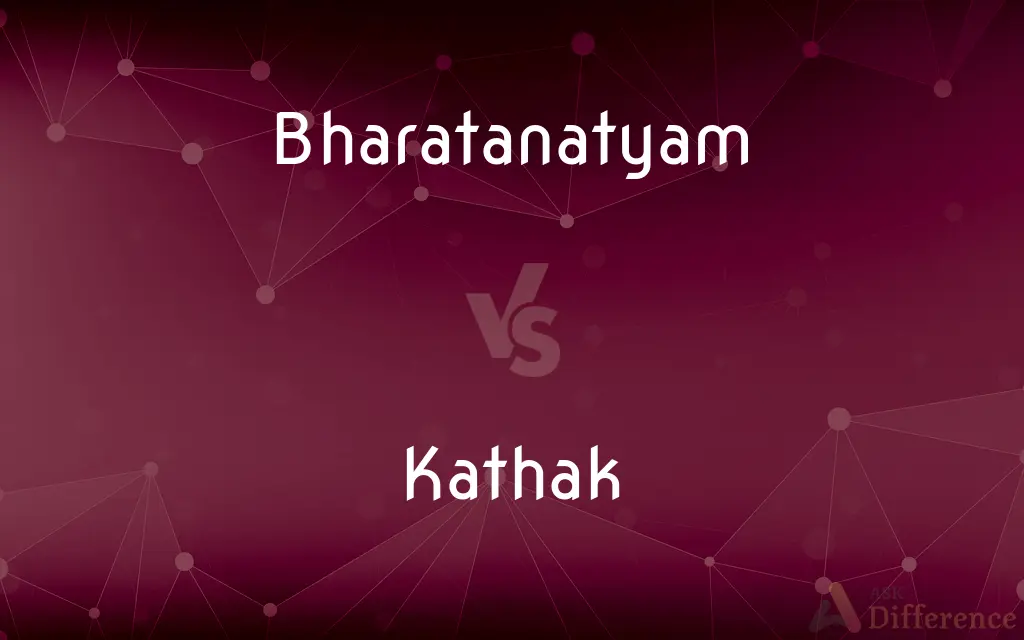Bharatanatyam vs. Kathak — What's the Difference?
By Urooj Arif & Fiza Rafique — Updated on March 19, 2024
Bharatanatyam originates from Tamil Nadu, India, emphasizing geometric positions and spiritual themes, whereas Kathak is from North India, known for fluid movements and storytelling through intricate footwork.

Difference Between Bharatanatyam and Kathak
Table of Contents
ADVERTISEMENT
Key Differences
Bharatanatyam and Kathak are both classical dance forms of India, each with a rich history and distinct style. Kathak, originating from North India, places a greater emphasis on footwork, with the dancer wearing ankle bells and performing intricate patterns on the rhythm. Unlike Bharatanatyam, Kathak's repertoire includes storytelling through dance, where the dancer narrates tales from epics like the Mahabharata and the Ramayana, as well as Persian and Urdu poetry, reflecting its historical influence by Islamic culture.
The musical accompaniment for each dance form also significantly differs. Bharatanatyam performances are usually accompanied by Carnatic music, a system of music commonly associated with the southern part of the Indian subcontinent. This music emphasizes vocal music; even when instruments are used, they are played in a manner that mimics singing. Kathak, on the other hand, is performed to Hindustani classical music, known for its emphasis on improvisation and exploration of all aspects of a raga (melodic framework).
Costuming in Bharatanatyam and Kathak also reflects their distinct aesthetic and historical backgrounds. Bharatanatyam dancers wear a tailored costume that includes a pleated piece of cloth draped over pants, enabling them to execute the precise geometric positions characteristic of the dance. The costume is richly decorated, complementing the dance's spirituality and discipline. Kathak costumes vary depending on the dancer's gender, with female dancers typically wearing a long skirt (lehenga) and a blouse (choli), often accompanied by a veil or scarf (dupatta), and male dancers wearing a kurta and churidar. The costumes are designed to enhance the fluidity and grace of Kathak movements.
The training and technique of both dance forms are rigorous but focus on different aspects of the dancer's skill set. Bharatanatyam training emphasizes the mastery of static poses, the nuance of facial expressions, and the symbolic gestures of hand movements (mudras) to tell stories. Kathak training, while also incorporating expressive gestures, places a stronger emphasis on footwork, spins (chakkars), and the dancer's ability to improvise rhythmically to the music.
Despite their differences, both Bharatanatyam and Kathak are performed worldwide, celebrated for their beauty, complexity, and the cultural heritage they represent. Each form offers a unique window into India's diverse historical, religious, and cultural landscapes, enchanting audiences with their distinct narratives, costumes, and musical accompaniment.
ADVERTISEMENT
Comparison Chart
Origin
Tamil Nadu, South India
North India
Focus
Geometric positions, spirituality
Fluid movements, storytelling, footwork
Music
Carnatic music
Hindustani classical music
Costumes
Pleated cloth over pants, rich decorations
Long skirt or kurta and churidar, designed for fluidity
Key Elements
Fixed torso, bent legs, hand gestures
Footwork, spins, improvisation
Historical Influence
Hindu religious themes
Islamic culture, Persian and Urdu poetry
Storytelling
Uses symbolic gestures to convey spiritual stories
Narrates tales through dance, often with vocal accompaniment
Compare with Definitions
Bharatanatyam
The art of expression in dance, conveying emotions and stories.
The dancer’s Abhinaya brought the ancient myths to life.
Kathak
The intricate footwork and rhythmic patterns of Kathak dance.
The dancer's Tatkar was so precise that each beat could be heard clearly.
Bharatanatyam
Pure dance movements, focusing on rhythm and aesthetics.
The Bharatanatyam recital began with an intricate Nritta sequence.
Kathak
Small, metallic bells worn around the ankles by Kathak dancers.
The sound of her Ghunghroo added a magical element to the performance.
Bharatanatyam
Symbolic hand gestures used in classical Indian dance.
Each Mudra in her performance had a specific meaning.
Kathak
Expressive part of Kathak, where the dancer tells a story or expresses emotions through gestures and facial expressions.
Through her Abhinaya, she narrated the story of Radha and Krishna.
Bharatanatyam
Basic steps or units of movement in Bharatanatyam, combining footwork, hand gestures, and eye movements.
She practiced several Adavus, perfecting her footwork and expressions.
Kathak
Spins or turns, a hallmark of Kathak dance.
His Chakkar sequences were dizzyingly fast yet graceful.
Bharatanatyam
Expressive dance, using facial expressions and gestures to tell stories.
Her Nritya portrayal of Goddess Durga was captivating.
Kathak
A fixed, melodic composition in Hindustani music to which Kathak dancers often improvise movements.
He performed a dynamic improvisation to the Bandish, showcasing his creativity and rhythm.
Bharatanatyam
Bharatanatyam (Tamil:பரதநாட்டியம்) also called as Sadhir Attam, is a major form of Indian classical dance that originated in Tamil Nadu. It has flourished in the temples and courts of southern India since ancient times.
Kathak
Kathak is one of the eight major forms of Indian classical dance. The origin of Kathak is traditionally attributed to the traveling bards in the northern areas of Ancient India known as Kathakars or storytellers.
Kathak
One of the eight classical dance forms of India.
Common Curiosities
What kind of music accompanies Bharatanatyam and Kathak performances?
Bharatanatyam is accompanied by Carnatic music, while Kathak performances are set to Hindustani classical music.
Where do Bharatanatyam and Kathak originate from?
Bharatanatyam originates from Tamil Nadu in South India, and Kathak originates from North India.
What are the key elements of Bharatanatyam?
Key elements include a fixed torso, bent legs, and detailed hand gestures (mudras) for storytelling.
How do historical influences differ between Bharatanatyam and Kathak?
Bharatanatyam is influenced by Hindu religious themes, while Kathak has been influenced by Islamic culture and Persian and Urdu poetry.
What distinguishes Kathak's style of dance?
Kathak is distinguished by its fluid movements, spins (chakkar), intricate footwork (tatkar), and the use of ankle bells (ghunghroo).
How do the costumes of Bharatanatyam and Kathak differ?
Bharatanatyam costumes are tailored and decorated to enhance geometric poses, whereas Kathak costumes are designed for fluidity and grace, reflecting gender-specific styles.
What is the significance of the costumes in these dance forms?
The costumes enhance the visual appeal and support the dance form’s unique movements and storytelling aspects.
How do dancers of Bharatanatyam and Kathak train differently?
Bharatanatyam dancers focus on mastering fixed poses and mudras, while Kathak dancers emphasize footwork, spins, and rhythmic improvisation.
How does the audience perceive these two dance forms?
Both dance forms are revered for their beauty and complexity, each offering a unique experience reflecting India's rich cultural heritage.
Can Bharatanatyam and Kathak tell stories?
Yes, both can tell stories; Bharatanatyam uses symbolic gestures and facial expressions for spiritual narratives, while Kathak focuses on storytelling through dance, including tales from epics and poetry.
What makes a Kathak performance unique in terms of musicality?
Kathak performances are unique for their improvisation with the rhythm and the interaction between the dancer’s footwork and the music.
What role do facial expressions play in these dance forms?
Facial expressions (abhinaya) are crucial in both dance forms for conveying emotions and telling stories.
Are there any gender-specific roles in these dance forms?
Traditionally, both dance forms were gender-specific, but today, dancers of any gender perform both Bharatanatyam and Kathak.
What is the global influence and presence of Bharatanatyam and Kathak?
Both dance forms enjoy a global presence, with schools and performances worldwide, showcasing the global appreciation for Indian classical dance.
Share Your Discovery

Previous Comparison
Certify vs. Confirm
Next Comparison
Husky vs. WolfAuthor Spotlight
Written by
Urooj ArifUrooj is a skilled content writer at Ask Difference, known for her exceptional ability to simplify complex topics into engaging and informative content. With a passion for research and a flair for clear, concise writing, she consistently delivers articles that resonate with our diverse audience.
Co-written by
Fiza RafiqueFiza Rafique is a skilled content writer at AskDifference.com, where she meticulously refines and enhances written pieces. Drawing from her vast editorial expertise, Fiza ensures clarity, accuracy, and precision in every article. Passionate about language, she continually seeks to elevate the quality of content for readers worldwide.














































